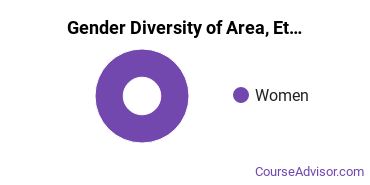Area, Ethnic, Culture, & Gender Studies at Piedmont International University
Every area, ethnic, culture, & gender studies school has its own distinct culture and strengths. We've pulled together some statistics and other details to help you see how the area, ethnic, culture, & gender studies program at Piedmont International University stacks up to those at other schools.Piedmont International University is located in Winston-Salem, North Carolina and approximately 951 students attend the school each year.
Want to know more about the career opportunities in this field? Check out the Careers in Area, Ethnic, Culture, & Gender Studies section at the bottom of this page.
Featured Piedmont International University Programs
Learn about start dates, transferring credits, availability of financial aid, and more by contacting the universities below.
Explore societal similarities and differences as seen through cultural, biological, archaeological and linguistic lenses when you earn one of your degrees in anthropology from Southern New Hampshire University.
Gain a rich foundation of knowledge ranging from early history to modern times with this online bachelor's degree in history from Southern New Hampshire University.
The online Master of Arts in History degree program can deepen your understanding of how history is made.
Piedmont International University Area, Ethnic, Culture, & Gender Studies Degrees Available
- Bachelor’s Degree in Area, Ethnic, Culture, & Gender Studies
Online Classes Are Available at Piedmont International University
If you are a working student or have a busy schedule, you may want to consider taking online classes. While these classes used to be mostly populated by returning adults, more and more traditional students are turning to this option.
Piedmont International University does offer online education options in area, ethnic, culture, & gender studies for the following degree levels for those interested in distance learning:
- Bachelor’s Degree
Featured Piedmont International University Programs
Learn about start dates, transferring credits, availability of financial aid, and more by contacting the universities below.
Explore societal similarities and differences as seen through cultural, biological, archaeological and linguistic lenses when you earn one of your degrees in anthropology from Southern New Hampshire University.
Gain a rich foundation of knowledge ranging from early history to modern times with this online bachelor's degree in history from Southern New Hampshire University.
The online Master of Arts in History degree program can deepen your understanding of how history is made.
Piedmont International University Area, Ethnic, Culture, & Gender Studies Rankings
The area, ethnic, culture, & gender studies major at Piedmont International University is not ranked on College Factual’s Best Colleges and Universities for Area, Ethnic, Culture, & Gender Studies. This could be for a number of reasons, such as not having enough data on the major or school to make an accurate assessment of its quality.
Area, Ethnic, Culture, & Gender Studies Student Demographics at Piedmont International University
Take a look at the following statistics related to the make-up of the area, ethnic, culture, & gender studies majors at Piedmont International University.
Piedmont International University Area, Ethnic, Culture, & Gender Studies Bachelor’s Program

About 57% of those who receive a bachelor's degree in area, ethnic, culture, & gender studies at Piedmont International University are white. This is above average for this degree on the nationwide level.
The following table and chart show the race/ethnicity for students who recently graduated from Piedmont International University with a bachelor's in area, ethnic, culture, & gender studies.

| Race/Ethnicity | Number of Students |
|---|---|
| Asian | 0 |
| Black or African American | 1 |
| Hispanic or Latino | 0 |
| White | 4 |
| International Students | 0 |
| Other Races/Ethnicities | 2 |
Concentrations Within Area, Ethnic, Culture, & Gender Studies
Area, Ethnic, Culture, & Gender Studies majors may want to concentrate their studies in one of these areas. The completion numbers here include all graduates who receive any type of degree in this field from Piedmont International University. Some of these focus areas may not be available for your degree level.
| Concentration | Annual Degrees Awarded |
|---|---|
| Ethnic Studies | 8 |
Related Majors
Related Programs
Learn about other programs related to Piedmont International University that might interest you.
Explore societal similarities and differences as seen through cultural, biological, archaeological and linguistic lenses when you earn one of your degrees in anthropology from Southern New Hampshire University.
Gain a rich foundation of knowledge ranging from early history to modern times with this online bachelor's degree in history from Southern New Hampshire University.
The online Master of Arts in History degree program can deepen your understanding of how history is made.
Careers That Area, Ethnic, Culture, & Gender Studies Grads May Go Into
A degree in area, ethnic, culture, & gender studies can lead to the following careers. Since job numbers and average salaries can vary by geographic location, we have only included the numbers for NC, the home state for Piedmont International University.
| Occupation | Jobs in NC | Average Salary in NC |
|---|---|---|
| Interpreters and Translators | 1,770 | $59,310 |
| Area, Ethnic, and Cultural Studies Professors | 260 | $82,580 |
References
*The racial-ethnic minorities count is calculated by taking the total number of students and subtracting white students, international students, and students whose race/ethnicity was unknown. This number is then divided by the total number of students at the school to obtain the racial-ethnic minorities percentage.
More about our data sources and methodologies.

